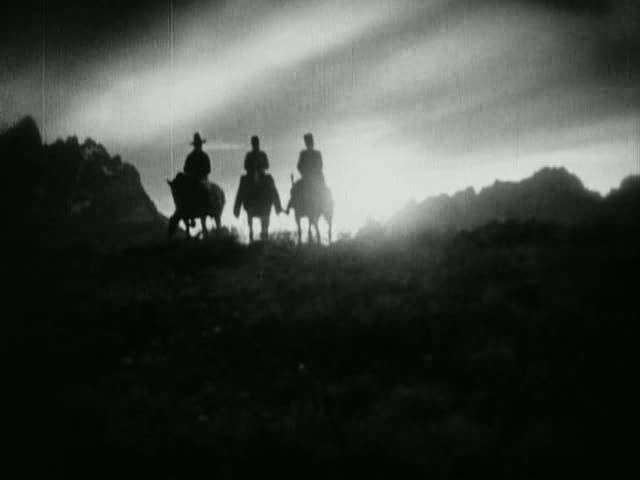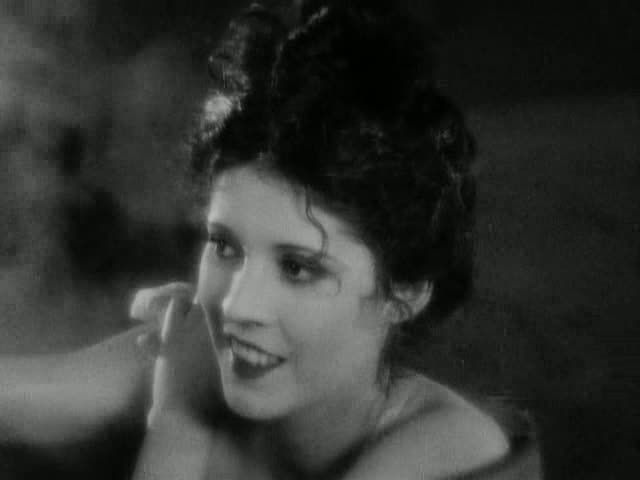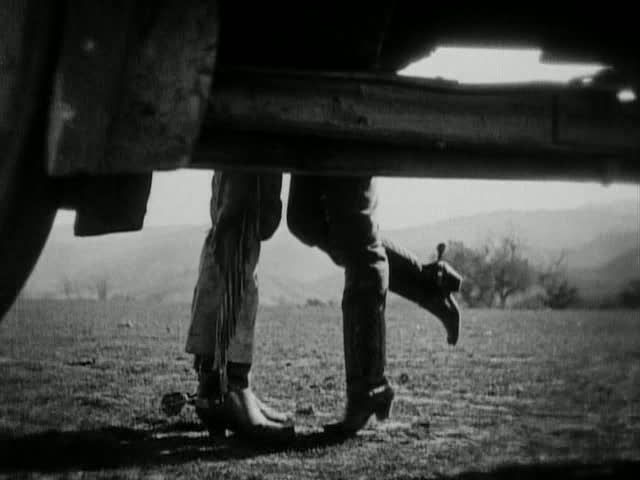

John Ford's Westerns consistently present the mythology of the Old West at its best, romanticizing and glorifying the westward expansion. This is true even very early on in his career. His 1926 silent 3 Bad Men is set in an ad hoc town that builds up at the border of the Sioux lands, which are set to be opened up to gold prospectors on a certain day, attracting speculators and settlers from all over, eager to earn their fortune in the newly opened territory. It's also a story of redemption, similar to his later 3 Godfathers, for three low-level outlaws — Bull (Tom Santschi), Costigan (J. Farrell MacDonald), and Spade (Frank Campeau) — who adopt Lee (Olive Borden), a girl whose father has been killed by vicious thieves. Lee, along with her admirer Dan O'Malley (George O'Brien), becomes a target for the evil, corrupt Sheriff Hunter (Lou Tellegen), who runs this small gold rush town and is also responsible for the murder of Lee's father.
Typically for Ford, he balances this dramatic story with a rich vein of humor, particularly in the scenes where Spade and Costigan, the two comic drunks among the titular three outlaws, try unsuccessfully to find a husband for the orphaned Lee by trawling the local bar. Particularly great is their stalking of a hapless, Chaplin-like dandy — they even check his teeth, like they're examining a horse — who reacts with quivering terror to the rough characters in this makeshift frontier community. There's also some nice humor in the title cards, which are a bit overwhelming towards the beginning of the film — when it seems like there's a lengthy title in between almost every shot — but quickly settle into a much smoother rhythm. At one point, a reporter announces, "they had a lot of trouble takin' out Spud Taylor's appendix — they had to kill him first," in one of Ford's references to the difficulties of the Western frontier.
The cinematography is potent throughout, with lots of typically grand frontier exteriors, including the first shot of the outlaws — riding over a hill, set off against the sun on the horizon — and the exhilarating sequences of large-scale wagon trains charging across the plains. The outdoor photography is gorgeous, imparting a sense of all the wide-open spaces, seemingly just waiting to be filled by the pioneers who flooded into the region, searching for gold or simply new land to settle and plow. Of course, there's little, if any, consideration of just what the Sioux thought about this scheduled invasion of their territory, other than a few probing, stone-faced closeups of Native Americans stoically watching the settlers and their wagons. The ethnic humor is also occasionally uncomfortable here, in the title cards that casually reference "dagoes" and "chinks" while casting the leading man as an Irish hero.


There are numerous powerful scenes here, though, and Ford's direction is confident and expressive. When Dan and Lee first meet, early in the film, Ford intersperses the titles — which establish a prickly attraction between the plucky, sarcastic heroine and the slightly goofy cowboy — with probing closeups that leave the actors plenty of room to define their characters entirely with their faces, their smiles and charged exchanges of glances. This introductory scene climaxes with the seemingly unceasing sexual tension of a kiss that never quite happens, even though both of them are on the verge of consummating the kiss, and Ford cuts to a shot of their legs, visible under the wagon, the girl raising one foot in anticipation. Later, he deftly stages a comic misunderstanding as Dan plays the harmonica for the bathing Lee, only to have another woman creep up behind him and sit down, with Dan assuming that Lee has joined him.
The action scenes towards the end of the film are especially great, as the three outlaws defend the young lovers against Hunter's hordes of criminals, proving that the "bad men" of the title aren't actually so bad after all. Hunter, mugging broadly and staring with wide, eyeliner-rimmed eyes, is the real villain, telegraphing vaguely effeminate creepiness in every shot he appears, and gradually the film focuses on the antagonism between him and the honorable outlaw Bull, whose sister Hunter has seduced and cruelly discarded. The final half-hour is one thrilling action set piece after another, starting with the great scene where Hunter and his thugs attack the preacher's cabin with flaming wagons. Ford shows the preacher, standing in front of a giant cross with the building engulfed in fire behind him, pleading with the villains, who simply cackle in response. The frenzied rescue, led by Dan and the noble outlaws, is exciting and formally enthralling, with smoke drifting everywhere, making the battlefield confused. This is followed by a tense sequence in which Hunter's henchmen pursue the good guys through a narrow canyon, with each one of the outlaws standing off against the encroaching hordes one by one, with the most memorable moment a showdown in a shack stacked with barrels of gunpowder.
This ending is somewhat predictable and schematic — it's obvious from early on that the outlaws will redeem themselves as a sacrifice to enable the formation of a happy nuclear family — but it doesn't detract from this taut, well-staged climax. The outlaws are sacrificing themselves, in a way, not only to save Dan and Lee, but to restore some order and security and decency to the unhinged West, to tame the frenzied rush for gold. This is a charming, funny and action-packed Western that displays one of the greatest directors of the genre at the top of his game.

2 comments:
Many believe this to be Ford's first true masterpiece, a position I won't commit to, but certainly won't question either. It's superbly photographed (as you note it's gorgeous and spacious) and edited, it's a grand epic that embraces the themes Ford would be examining through his career, and the acting is of the top rank. I do agree that the ethnic humor is in poor taste, but this is emblematic of the period rather than the director, and American films were recipient to this kind of treatment right through the pre-code era. Agreed that the final half hour is wholly gripping and exceptionally choreographed.
Again, you've penned a marvelous essay on an exceptional early Ford.
Thanks, Sam. I haven't yet seen enough of Ford's earliest work to say for sure one way or the other, but this is probably the most complete statement from him that I've seen at this early stage of his career. It's a great film, and you're right that the jarring, wince-inducing ethnic humor is down to the period as much as to the director, especially since much of it shows up in the title cards only.
Post a Comment